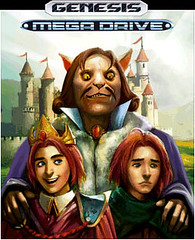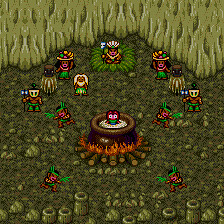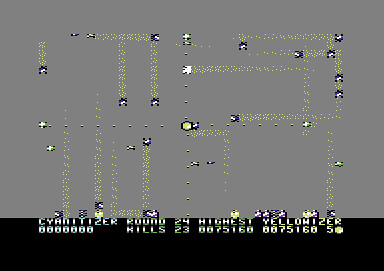Posts from ‘Homebrew’ Category
IGS ’09: The Four-Hour Game Design (Cactus)
By: Brandon McCartin (BMcC)
On: March 23rd, 2009

Jonatan “Cactus” Söderström’s lecture for the 2009 Independent Games Summit, The Four-Hour Game Design, opened up his bizarre creative process, revealing some of the design guidelines and key tricks that have allowed him to make more (awesome) games per day than the rest of the industry combined manages to put out in a year.
It may have been the greatest presentation ever.
Starting from his Desktop, Cactus skipped over a few folders called things like “Weird Porn” and “Nude Pictures of Me” to one simply named “GDC.” Within, bearing the icon of a pixelated heart, was his presentation… made in Game Maker.
After registering Windows Media Player live on stage to test the audio, and eventually realizing he had to un-mute his laptop, Cactus started it up. A Brain-Damaged Toon Underworld style animation began with a character only he could have drawn declaring, “I AM INTERNET.”

I ripped some (TIGSOURCE EXCLUSIVE) screens from Cactus’ laptop while he was asleep, but there will eventually be a video of all the “slides,” or perhaps even a download of the presentation/game itself, so I won’t spoil too much of it now. Here’s a brief summary, in the extended:
Don’t Make Games In Four Hours If You Stink

In the first section of the presentation, “WHY,” Cactus likened game development to “having a baby,” then proceeded to drive that metaphor well past the line of any decency, with upsetting photos to boot.
Highlight: The hardest part is “getting it out”—it’s painful and the end result is often not what you expected. (But at least you learn from it.)
When You Make A Game, Try To Make A Good One
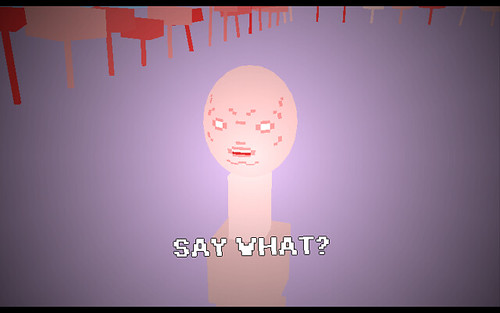
The main points of the second section, “CREATIVITY,” were: Always experiment, be serious about what you’re doing, renew your concepts, don’t think the game needs to be fun (it could be “interesting or weird or just freak you out”), and try to create a cohesive experience.
For times when you’re not feeling creative, Cactus recommended mimicking another game, but challenging its original concept, trying to do things better in some way. (This bit was supplemented by a trippy 3D scene of dialog between two polygonal characters, which I now know had randomized camera angles.)
Try To Be Original When You Make An Original Game
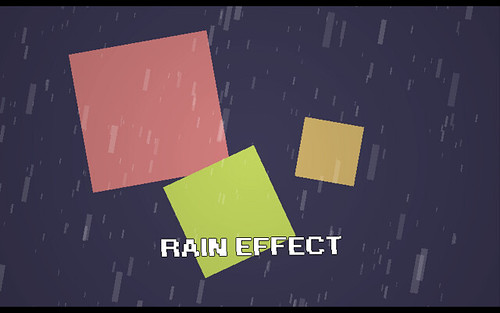
In the third section, “GRAPHICS,” Cactus outlined a number of simple ways to use your game’s tech to multiply the effectiveness of basic, easy-to-produce art assets (such as sketches, pixel art, geometric shapes, and so on). He then gave many strange examples of using color & saturation, rotation, scaling, basic animation, flicker, movement, atmosphere (“RAIN EFFECT”), and other quick tricks to make the visuals considerably more interesting without too much extra work.
Sometimes Games Don’t Have To Be Fun
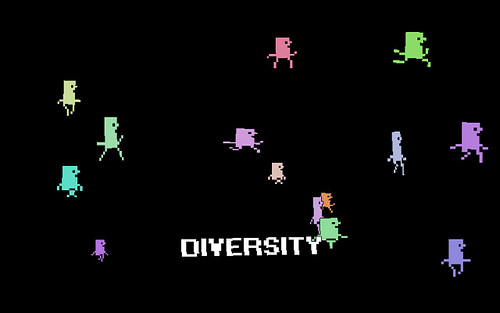
In the fourth section of the presentation, “GAMEPLAY,” Cactus asked the age old question: “Who wants to jump on an enemy that many times?”
He then went on to show a few minor gameplay changes in different situations that have a huge impact on the feel of the game. For example, he played a potential horizontal shmup where you must shoot incoming square “asteroids” a bunch of times to destroy them. A bit later he played an updated version that was faster, with less hits required to destroy each asteroid, and a quick explosion effect that made the game clearly more awesome. Unfortunately, he lost pretty quickly when playing this, so he had to move on.
Don’t Work Too Hard, You’ll Get Tired
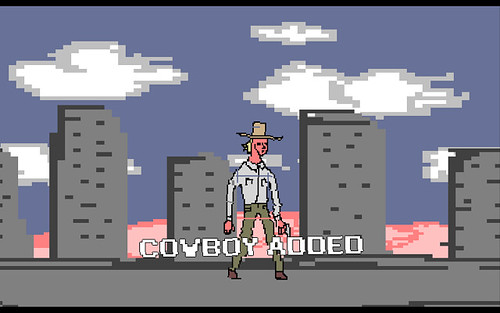
In the fifth section, “PREPARATIONS,” Cactus gave some health advice, pointing out the critical importance of going to the bathroom, eating (but not too much, unless you want to end up in the bathroom again), having an idea ready before you start, using the right tools, and taking every shortcut possible.
If you work cleverly and take care of yourself, you won’t need to work as aggressively, either, and the game will become less of a headache to pull together.
Games Made Of Rock Don’t Always Rock

In the final section of the lecture, Cactus pointed people toward TIGForum member Dr. Petter’s excellent SFXR, which he’s been using for pretty much every project nowadays, and recommended collaboration with online musicians eager to compose. (That, or stealing their music. But if your game wins an award or something, “it might be a good idea to email” them about it.)
A final tip was displayed, “Some Games Have Good Music,” and the slideshow abruptly ended. The audience sat in silence for moment wondering if there was going to be another curve ball, but once it was understood that the thing was actually over, the room erupted into applause.
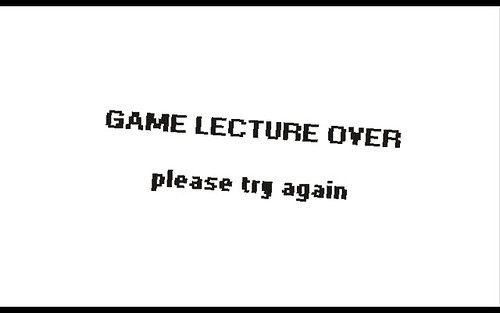
Now, to a game developer, the direct content of this presentation didn’t give that much new information, but, at least for me and everyone else I talked to, as a whole it was incredibly inspiring and enlightening. I imagine a number of developers well aware of these techniques may not have thought to really use them like this. And if anyone in the room hadn’t heard of Cactus before, this must have been a knockout. It was just as free-form, exciting, and sometimes confounding as a Cactus game, and surely one of the most interactive, unpredictable talks GDC has ever seen.
Even giving a lecture, Jonatan can’t help being Cactus.
P.S. He made, like, forty more games while he was speaking.
But Wait!
By: Derek Yu
On: January 29th, 2009
Let me preface this by saying that I realize that this slightly off-tangent post isn’t going to appeal to everyone!
It’s just that the past couple of months I’ve really gotten into watching nostalgic game reviews while I’m working. Stuff like The Angry Video Game Nerd and The Spoony Experiment (Spoony’s Phantasmagoria 2 playthrough is all kinds of brilliant). Benzaie is another reviewer I enjoy, although he’s admittedly even more of an acquired taste. But I love his absurdist sense of humor, his thick, sexy French accent, his unbridled, and often misplaced, enthusiasm for things (just like me!), and his unmistakable catch phrase… “But wait!”
Sadly, I’ve now seen every one of these videos on the internet that’s worth watching, and my only recourse now is to torture you all by posting about them on TIGSource, thus lowering my journalistic integrity from rock bottom to Earth’s mantle. Thank goodness this particular video is about two homebrew Dreamcast games (Last Hope and Wind and Water: Puzzle Battles). Sure, they’re both about two years old, but hey! It’s still INDIE! Cue screaming and weeping.
Legend of Wukong
By: Derek Yu
On: December 20th, 2008


Super Fighter Team, which was responsible for the the worldwide release of Beggar Prince, has produced yet another classic-style, 16-bit Sega Genesis/Megadrive game, Legend of Wukong. Like Beggar Prince, this cartridge-based, Taiwanese RPG comes in a very authentic-looking black clamshell case (with a full-color instruction manual) and you can purchase it online for $48. This is pretty serious homebrew!
The graphics in this one look a little more rough than Beggar Prince (although still charming), but it’s cool to see a Taiwanese game in English. And the main characters are based on Journey to the West, which is one of THE classic stories from China, which is sadly under-heard of in the Western world. It’s ridiculously cool and weird.
You can see a short video of Legend of Wukong here.
(Source: Brandon, via Insert Credit)
Interview : Matthias Nagler
By: Shabadage
On: October 18th, 2008
I recently had the pleasure of conducting an interview with Matthias Nagler. For those of you unaware, Matthias recently earned himself the distinction of being the first person to produce an 8 simultanous player SNES game. The game in question is N-Warp Daisakusen, and can be handily downloaded at his website.
Matthias was kind enough to agree to an interview, and during the course of this interview I began to realize exactly how devoted Matthias is to his craft.
===
TIGS: Well I suppose we should start this off with the good old standard introduction.
Matthias: My name is Matthias Nagler, I’m currently living in Germany and was born in 1983. I usually go by the name of d4s on the net.
TIGS: So how long have you been doing hobbyist console programming? Is the SNES your first experience with console programming?
Matthias: Yeah, the SNES is the first and only console I’ve coded for so far. Actually, I didn’t have any programming experience prior to that at all.
Must have been around three years ago. I started out with trying to reverse-engineer and modify commercial games before I got bored with that and wanted to create something original from scratch. The reason I started coding on the SNES was that I love this machine so much, so many good memories…
TIGS: Wow, talk about jumping into the fire! So did you start programming in assembly from the get go, or did you learn another language then ease yourself into ASM?
Matthias: 65816 Assembler was the first programming language I learned, yeah. Assembler is considered obsolete by quite a few people, but I really love how you’re almost directly interfacing with the hardware in ASM. On old and slow consoles, you hardly have a choice, anyway.
TIGS: Your game has earned the distinction of being the first simultaneous 8 player SNES game. What made you decide to go with 8 players?
Matthias: The idea to program this particular game crossed my mind about 3 or 4 days before going to a small Nintendo gaming convention in Germany called N-Warp. I thought it would be nice to have a simple minigame that would be so easy to learn, play and master that everybody could join right in and compete. Regarding the number of players, I just had the feeling that more players on-screen would mean more fun. ;)
Eight is the maximum number of joypads you can connect to the SNES with official peripherals, so I went with that.
TIGS: Tell us a little more about N-Warp. How large is this event and what does it cover (Enthusiasts/programmers/etc)?
Matthias: It is just a really small gathering of about 50 people. Has nothing to do with programming, either, it’s just a gaming party of sorts. All the people there are hardcore Nintendo fans, but most of them probably didn’t even know that it’s possible to develop your own SNES games beforehand. ;)
TIGS: In terms of technical limitations, was it difficult to actually incorporate 8 players? Somehow it seems that the SNES was never actually designed to support more than 4 controllers.
Matthias: It isn’t difficult at all. I’m using two Multitaps on each joypad port of the SNES. Each Multitap has 4 additional joypad ports for a total of eight controllers. As long as you know how to access the Multitap, it’s very straight forward.
I think the reason why licensed SNES games never supported more than five controllers is that Nintendo enforced a couple of rules regarding this device.
If you wanted to use the Multitap in your licensed game, it had to be plugged into joypad port 2 on the SNES. You even had to spit out an error message if the user tried to connect it to port 1.
It’s not perfectly clear why they wanted to have it that way. Chances are they either didn’t want to confuse consumers, or it was due to power consumption.
Either way, the Multitap does work perfectly fine in both ports.
TIGS: Considering this game was made with your in-progress engine in a rather short time, will we ever see this game expanded? Any plans to make a (separate) full game when you are finished with the engine?
Matthias: Honestly, I don’t know yet. I have a habit of not going back to my previous projects so chances are that I won’t expand this game once it’s released. It was never designed to be more than a quick multiplayer fix and I pretty much like it that way.
It may not be a full game, but nevertheless, I think it’s important to get it out there to show the people that somebody still cares. I’d be glad if this would spark some interest for SNES development again.
As for future projects, I will most certainly try to come up with something and you can bet it will be on the SNES. There’s no master plan yet, I’m just playing with ideas at the moment.
I’d love to create a full game with a group of dedicated people at some point in the future, though.
TIGS: I’ve also seen videos of your advanced SNES loader. Think you can give a quick rundown on what it does/how it functions? How would one go about using this on their SNES?
Matthias: Actually, it’s not a loader, but a modified, region-free Super Nintendo. It basically adds a firmware to the SNES. When you start it up, it displays all sorts of useful information about the inserted game cartridge, switches to the right video mode and stuff like that. Technically, it’s a custom chip and a firmware flashrom on a pcb that’s soldered into an SNES, so it is probably comparable to modchips for other consoles. The difference being that it is not for playing pirate games, but running imports and doing it with style.
I’ve just produced a limited run of 50 units and these are long sold out, I’m afraid. This wasn’t meant to be assembled by the user. I mainly wanted to test waters and gauge interest with that project.
TIGS: I imagine you’ve played your fair share of SNES games, so which ones are your favorites?
Matthias: Yeah, I’ve played quite a few. My favorite games on the SNES are Seiken Densetsu 3 (japanese sequel to Secret of Mana), Treasure Hunter G (again, japanese RPG) and Battletoads in Battlemaniacs.
TIGS: Massive love of the SNES aside, do you think you’ll ever cross over to another home console, living or dead? I’ve been itching for a new classic gameboy game myself.
Matthias: It’s a possibility for sure. For example, I`m quite interested in the Virtual Boy. I just can’t think of an interesting project for that one right now.
Me working on more recent consoles is probably less likely. One of the things I enjoy about older consoles is overcoming quirky hardware limitations. If it gets too easy, it becomes less interesting to me.
TIGS: Obligatory plugging of your website goes here!
Matthias: http://gra.dforce3000.de/ is the page that’s supposed to cover all my homebrew projects from now on, I think that’s the most relevant one for now. You can download the game there as well, if you want to give it a try.
TIGS: Well I think we’ll call it a wrap here! Thanks so much for agreeing to this interview! Any final words for our loyal TIGSource readers?
Matthias: I’m the one who has to thank you! What really surprised me is how friendly and helpful the community around TIGS is, I think you just got yourself another reader. Looking forward to talk to you on the forums! =)
Knytt Stories…on the DS?
By: Shabadage
On: August 28th, 2008
Just stumbled across this video. Apparently a fan of Knytt Stories is in the process of porting the golden child freeware game over to the DS.
While it’s not done yet, it seems to be coming along quite nicely!
The Uzebox Project
By: Derek Yu
On: August 26th, 2008
You know, I’ve been waiting for something like this for a long while! The Uzebox is an open-source homebrew retro game console based on Atmel’s AVR 8-bit general purpose microcontroller. Its creator, “Uze,” has designed the system to be simple, but relatively powerful, so that hobbyists can easily put together their own system. Games can be programmed in C, using free software, and are compiled with the kernel and then flashed directly onto the main chip.
“AVR Megatris,” the Tetris DS clone Uze developed for the system, looks and sounds pretty good! The Uzebox supports 256 simultaneous colors onscreen, a 240×224 (40×28 tiles) screen resolution, a 4-channel sound engine, a MIDI In input port, and 2 NES joystick ports. It also has 4k of RAM and an overclocked speed of ~28.6 MHz.
The source and schematics are both available for download on the Uzebox website, under GPL. This would make a fun, and nerdy, weekend project. I’d love to see people develop games for this thing!
(Source: Brandon, via insert credit)
Beggar Prince Third Production Run
By: Derek Yu
On: December 4th, 2007
Beggar Prince, released in 2006, was the last SEGA Megadrive/Genesis game ever made, and has already gone through two production runs which sold out very quickly.
I’m happy to say that this fantastic-looking RPG is now hitting its third production run. Unlike the first two, this version is now playable via not only the Genesis, but also the Nomad, 32X, CDX, X’Eye, Laseractive, and other compatible systems. The team behind the game has also upgraded the decidedly amateurish boxart, replacing it with the creepy-awesome art you see at the right.
It’s really cool to see people with enough passion to create a game for old hardware and put it in the traditional packaging. If my old Genesis worked, I’d be all over this like a moustache on a freaky cat minister.
Check out Sega-16 for more information, including reviews and a forum thread where the developers discuss the game. The game is currently selling for $46 US, including shipping/handling and PayPal fees.
(Source: Insert Credit)
Redrunner
By: Derek Yu
On: October 5th, 2007
Redrunner is the sequel to Greenrunner, a C64 homebrew by Aleksi Eeben. Both games are based on Jeff Minter’s Gridrunner series of games (which are apparently getting an Xbox 360 update). And Blade Runner is a great dystopian science fiction movie starring Harrison Ford. Got that?
Redrunner has roots in the classic arcade game Centipede, so it shares many of the same elements, although Redrunner’s gameplay is much more free form. In this game the entire playfield is open to you, and your opponents, the “bugs,” are similarly free to roam the entire screen.
What’s neat about the game is that each of the game’s 100 (!) levels has a unique theme. One level, for example, may go in slow motion, whereas in another level an ever-expanding slime may steadily consume the screen.
Unfortunately, I found it difficult to appreciate the concept, mostly due to the fact that, because of the jittery pace of the game and your ship’s ability to fire in the four cardinal directions at once, the easiest way to beat many of the levels is by sitting still and holding down the fire button. Gameplay videos by the author himself seem to verify that this is a reasonable tactic.
I do dig the overall aesthetic, especially the voice of the announcer, who sounds like Sinistar crossed with the guy who goes “Test your might!” in the Mortal Kombat song. This game’s not for me, though.
Redrunner requires a C64 or a C64 emulator like Vice to run.
(Source: dessgeega blog)
Megazeux DS
By: Derek Yu
On: September 25th, 2007
Megazeux (MZX), the popular game creation system based on the Tim Sweeney’s legendary ZZT, has been ported to the Nintendo DS by MZX developer and homebrew hacker Kevin Vance.
I had a good time playing with Megazeux as a kid! The simplicity of the engine is great, and it only takes a few hours to make something fun. Some of the classic MZX games (like Bernard the Bard, pictured above) are extremely clever. Good to see it on the DS!
Download MZX for the PC here (Sourceforge), and try the games at DigitalMZX (MZX is required to play).
(Source: Mr. Apol from the selectbutton.net forums!)
Joe Gunn
By: Derek Yu
On: September 5th, 2007
Everyone loves tomb raiding, right? Dusty passageways, deadly traps, mysterious ruins, ancient treasures… snakes. It’s adventure and exploration and legend and all that good stuff. It’s Indiana Jones, man!
Well, there have been a lot of games set in the “Indyspace,” and some have been good and some have been bad. Joe Gunn, a newish C64 homebrew from George Rottensteiner, is definitely one of the good ones. What can I say? It’s old-fashioned platforming the way Ra intended, with 70 rooms, and plenty of items, puzzles, and secrets. And it nails the theme to the floor, right down to the great “Egyptian” music.
If you thought La Mulana was cool, but couldn’t get into it because it is so frickin’ difficult, give this one a try. It’s not easy, by any means, but it’s much more forgiving than NIGORO’s unholy beast.
Joe Gunn requires a C64 or a C64 emulator. Terry (who recommended the game, thanks!) recommends Vice. Don’t forget to configure Joystick II before you start.
See the extended for controls:
Walk – Left / Right
Climb Ladders – Up / Down
Jump – Hold Fire and press Left / Right (can be done on ladders)
Examine – Hold Fire and press Down
Use an Item – Hold Fire and press Up, then Up / Down to cycle items
At certain points in the game you will be able to climb ropes. Grab the ropes by pressing Up and press Down to let go. You can only grab onto a rope when you’re standing.
There’s no way to save in the game and it’s possible to get stuck, so be careful!
